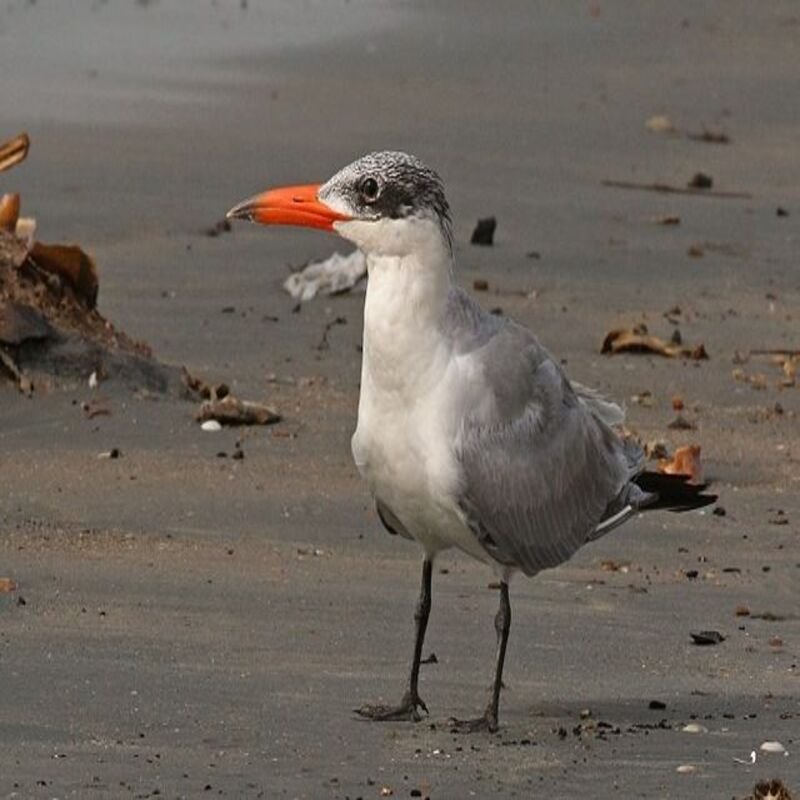The Caspian tern (Hydroprogne caspia) is a subcosmopolitan yet scattered tern species. Despite its wide range, it is monotypic within its genus and does not have any recognized subspecies. The genus name is derived from the Ancient Greek hudros, meaning “water,” and the Latin progne, meaning “swallow.” Caspia is a Latin term that, like the English term, refers to the Caspian Sea.
Quick Overview: Hydroprogne Caspia – Caspian Tern
Body size: Around 19-23 in (48-58 cm) and a weight of 782 g (24.58 oz)
Main colors: Gray, White, Black, Red
Range: Throughout the United States
Migratory Bird: Yes
Best time of the year to see in the U.S.: March, April, May, September, October, November
Conservation Status: Least Concern
Caspian Tern Description
The upperparts of this huge stocky tern are pale gray, while the underparts are white. The cap is black and may appear to have a slightly crested appearance. Coral-red is the color of the huge bill, gray is the color of the primaries’ undersides, a short white tail is somewhat forked, and the legs are black.

Size
These birds have a length of 19-23 in (48-58 cm) and a weight of 782 g (24.58 oz). Their wings could range from 50-55 in (127-140 cm).
Feeding
Primarily fish. Frequently focuses on a few prolific fish species in a particular location (for example, shiner perch on California coast, alewife on Great Lakes). Additionally, it feeds on insects and occasionally on the eggs or young of other birds.
Habitat
Typically, the Caspian Tern forages in open wetlands, such as lakes and rivers. They are frequently found in protected shallow water near the margins but are sometimes seen in open coastal seas.
Behavior
These terns feed largely on mullet and menhaden. They consume crayfish and insects sometimes. They fly above and plunge dive or capture fish at the surface. Additionally, they steal food from other birds.
Hydroprogne Caspia Scientific Classification
- Kingdom: Animalia
- Phylum: Chordata
- Subphylum: Chelicerata
- Class: Aves
- Order: Charadriiformes
- Family: Laridae
- Genus: Hydroprogne
- Species: Hydroprogne caspia
Best time of the year to see
In the United States, the best time of year to see these birds are during the Spring season (March-May) and during the Autumn season (September – November).
Distribution of the Caspian Tern in the USA
Breeds in scattered colonies over central Canada, the Great Lakes, and Newfoundland, and south to the Gulf of Mexico and Baja California. Winters are spent in northern California and North Carolina. Additionally, this species breeds in Eurasia, Africa, and Australia.
The Caspian Tern can be found in the following states in the United States – Alabama, Alaska, Arizona, Arkansas, Connecticut, Delaware, Florida, Georgia, Hawaii, Idaho, Illinois, Indiana, Iowa, Kansas, Kentucky, Louisiana, Maine, Maryland, Massachusetts, Michigan, Minnesota, Mississippi, Missouri, Montana, Nebraska, Nevada, New Hampshire, New Jersey, New York, North Dakota, Ohio, Oklahoma, Oregon, Pennsylvania, Rhode Island, South Carolina, South Dakota, Tennessee, Texas, Utah, Vermont, Virginia, Washington, West Virginia, Wisconsin, and Wyoming.
